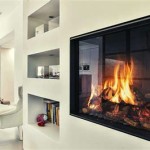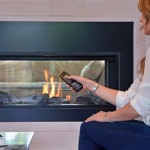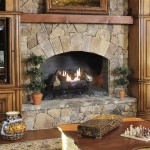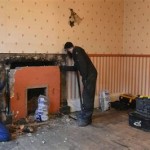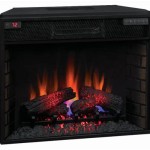Pellet Burning Fireplace Inserts With Blower: Efficient Heating and Comfort
Pellet burning fireplace inserts with blowers represent a significant advancement in home heating technology. They offer an efficient and relatively clean-burning alternative to traditional wood-burning fireplaces, while also providing enhanced control over heat distribution. These inserts are designed to fit into existing masonry or prefabricated fireplace openings, effectively transforming a less efficient, and potentially drafty, fireplace into a powerful supplemental heating source.
The fundamental principle behind a pellet burning fireplace insert revolves around the combustion of compressed wood pellets. These pellets are typically made from recycled wood waste such as sawdust and wood shavings. This makes them a renewable and sustainable fuel source compared to fossil fuels or traditional firewood. The pellets are automatically fed from a hopper, a storage container integrated into the insert, into a burn pot where they are ignited. The combustion process generates heat, which is then circulated into the room by a blower fan. This forced-air circulation ensures that the heat is distributed more evenly and efficiently compared to the radiant heat produced by an open fireplace.
The incorporation of a blower is a crucial element in the overall effectiveness of a pellet burning fireplace insert. Without a blower, much of the heat generated would simply rise up the chimney, similar to a conventional fireplace. The blower actively draws air from the room, passes it through the heat exchanger within the insert, and then expels the warmed air back into the room. This significantly increases the heating capacity and efficiency of the unit, allowing it to warm a larger area and reduce reliance on other heating systems.
Understanding the Components of a Pellet Burning Fireplace Insert
A pellet burning fireplace insert is a complex piece of machinery comprised of several key components working in tandem. Understanding these components is essential for proper operation, maintenance, and troubleshooting.
Firstly, the
hopper
is the container that holds the wood pellets. Hoppers come in various sizes, influencing how frequently the homeowner needs to refill the fuel supply. Larger hoppers provide longer burn times between refills, but may also require more floor space. The size of the hopper should be selected based on the heating needs of the space and the frequency with which the homeowner is willing to load pellets.Secondly, the
auger
is a screw-like mechanism that transports the pellets from the hopper to the burn pot. The auger’s speed is typically controlled by the insert’s electronic control panel, allowing for precise adjustment of the fuel feed rate. This precise control is vital for maintaining a consistent burn and regulating the heat output of the insert. Malfunctions of the auger are common causes of operational issues and require periodic inspection and maintenance.Thirdly, the
burn pot
is the area where the pellets are ignited and combusted. Burn pots are typically made of cast iron or steel and are designed to withstand the high temperatures generated during combustion. Proper airflow to the burn pot is crucial for clean and efficient burning. Regular cleaning of the burn pot is essential to remove ash and clinkers that can impede airflow and reduce efficiency.Fourthly, the
blower
, as previously discussed, is responsible for circulating the heated air throughout the room. The blower's speed may be adjustable, allowing the user to control the airflow and heat distribution. The blower motor requires periodic cleaning and lubrication to ensure optimal performance. Buildup of dust and debris can reduce the blower's efficiency and potentially lead to overheating.Fifthly, the
exhaust system
vents the combustion gases outside the home. Pellet stoves require a specialized exhaust system, typically made of stainless steel, that is designed to withstand the corrosive effects of the combustion gases. Proper installation and maintenance of the exhaust system are critical for safety and efficiency. A blocked or improperly installed exhaust system can lead to dangerous carbon monoxide buildup inside the home.Finally, the
electronic control panel
manages the operation of the entire system. This panel allows the user to adjust the fuel feed rate, blower speed, and other settings. Many modern inserts feature programmable thermostats and remote controls for added convenience. The control panel also typically includes diagnostic features that can alert the user to potential problems with the insert.Benefits of Using Pellet Burning Fireplace Inserts with Blowers
Pellet burning fireplace inserts with blowers offer a range of benefits over traditional wood-burning fireplaces and other heating methods. These benefits contribute to their growing popularity as a supplemental heating source.
Firstly, they offer
high heating efficiency
. Pellet stoves are significantly more efficient than traditional wood-burning fireplaces. A well-maintained pellet insert can achieve efficiency ratings of up to 80% or higher, meaning that a greater percentage of the fuel's energy is converted into usable heat. This increased efficiency translates into lower fuel costs and reduced environmental impact. The precise control over the fuel feed rate allows users to optimize the heating output based on their specific needs and preferences.Secondly, they offer
environmental advantages
. Pellet stoves burn relatively cleanly, producing significantly less smoke and particulate emissions than traditional wood-burning fireplaces. Because pellets are made from recycled wood waste, they also contribute to reducing landfill waste. Many pellet inserts also qualify for tax credits and other incentives due to their environmental performance.Thirdly, they offer
convenience and ease of use
. Pellet stoves are much easier to operate than traditional wood-burning fireplaces. The automatic fuel feed eliminates the need to manually load wood, and the electronic control panel provides precise control over the heating output. Many models also feature programmable thermostats and remote controls for added convenience.Fourthly, they offer
improved safety
. Pellet stoves are generally safer than traditional wood-burning fireplaces. The enclosed combustion chamber and controlled fuel feed reduce the risk of sparks and embers escaping, minimizing the risk of fire. The specialized exhaust system also helps to prevent the buildup of dangerous carbon monoxide inside the home.Fifthly, they offer
consistent heat output
. Pellet stoves provide a more consistent and predictable heat output than traditional wood-burning fireplaces. The automatic fuel feed ensures a steady supply of fuel, resulting in a more even and comfortable temperature. This consistency is particularly beneficial during long periods of cold weather.Factors to Consider When Choosing a Pellet Burning Fireplace Insert with Blower
Selecting the right pellet burning fireplace insert with a blower requires careful consideration of several factors to ensure that the chosen model meets the specific needs and requirements of the homeowner.
The
size and heating capacity
of the insert are crucial considerations. The insert should be sized appropriately for the size of the room or area that needs to be heated. Overly large inserts can overheat the space, while undersized inserts may struggle to maintain a comfortable temperature. Heating capacity is typically measured in BTUs (British Thermal Units) per hour. It is recommended to consult with a qualified professional to determine the appropriate BTU rating for the space being heated.The
hopper size
should also be taken into account. Larger hoppers require less frequent refilling, but may also take up more space. The ideal hopper size depends on the heating needs of the space and the homeowner's preference for refilling frequency. Consider how often you are willing to refill the hopper based on your lifestyle. A larger hopper is preferable for those who desire less frequent maintenance.The
blower capacity
is another important factor. The blower should be powerful enough to circulate the heated air effectively throughout the room. A blower with multiple speed settings allows for greater control over the airflow and heat distribution. Assess the room's layout to ensure the blower can effectively reach all areas.The
efficiency rating
of the insert should also be considered. Higher efficiency ratings translate into lower fuel costs and reduced environmental impact. Look for inserts that are EPA-certified and have high efficiency ratings. Review the Energy Star ratings to compare different models.The
features and options
offered by the insert can also influence the decision. Programmable thermostats, remote controls, and self-cleaning features can add convenience and ease of use. Evaluate the features that are most important to you and choose a model that offers those features.Lastly, the
cost
of the insert, including installation, should be considered. Pellet stoves can range in price from a few hundred dollars to several thousand dollars. It is important to factor in the cost of installation, which can include modifications to the existing fireplace and exhaust system. Obtain multiple quotes from qualified installers to ensure a competitive price.In conclusion, pellet burning fireplace inserts with blowers offer a compelling combination of efficiency, convenience, and environmental benefits, making them a viable alternative to traditional fireplaces and other heating methods. Careful consideration of the key components, advantages, and selection factors will enable homeowners to choose the right model for their specific needs and enjoy the benefits of efficient and comfortable heating.

Pellet Fireplace Inserts Lopi Stoves Made In Usa

Gci60 Cast Iron Pellet Stove Insert Regency

Pellet Fireplace Inserts Lopi Stoves Made In Usa

Enviro M55c Pellet Insert Combustion Exhaust Blower 50 2377 Gc160 Friendly Fires

Pellet Fireplace Inserts Insert Installation In Burlington Wi More

Fireplace Insert Stoves Wood Gas Pellet Traditional Baltimore Maryland

Wood Stoves Pellet Gas Fireplace Inserts

Pellet Fireplace Inserts Complete Home Concepts

Ventis Hei240 Wood Burning Insert Rockford Chimney

Fireplace Insert Installation Wood Inserts Gas Pellet And Electric
Related Posts




